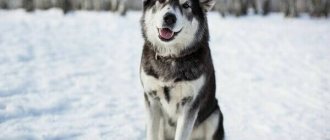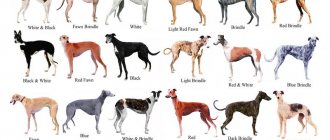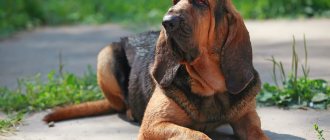Difference between the average life expectancy of females and males
Gender affects the lives of pets. Bitches live longer because they are less likely to have diseases of the nervous, endocrine, musculoskeletal, digestive and genitourinary systems. They are susceptible to ovarian cysts, hypothyroidism and food allergies.
Take the Attention Test! Find 10 differences! (click right here!)
Find the answer Are you bothered by some problem or question? Enter “Breed” or “Name of the problem” into the form, press Enter and you will find out everything about the issue that interests you.
Training and education
Poorly trained . They are friendly and peace-loving dogs, but if they are stubborn, this can lead to problems in training. You can teach the necessary skills by getting the dog interested or in a playful way.
Submitting a dog doesn't always work. The principle of complete submission of the beagle to the owner is an outdated method. This theory was formulated based on observations of packs of wild wolves, but they were kept in captivity and, of course, experienced stress. The stress condition forced wolves to show aggression towards each other, but in the wild they do not show aggression to each other - they live together and interact with each other. You need to perceive yourself as the more experienced and mature member of the pack, who is responsible for guiding the new member (beagle puppy) and teaching him good behavior, as well as correcting him if necessary. It is important to remember that Beagle puppies learn a lot on their own. They are very inquisitive, love to explore new territories and, of course, experiment. Puppies tend to repeat actions they enjoy (like playing with a toy). They do not repeat actions that cause them pain (for example, destroying a nest and getting bitten). If your Beagle puppy misbehaves, ignore him and praise him when he does the right thing. Reward your puppy for following commands and good behavior. Do not neglect these tips. After all, constantly hearing “you can’t” all day long is unbearable. This is a small child who wants to know everything and get his portion of treats as a reward for not eating your favorite rug, going to the toilet outside, bringing you a ball, and so on.
Set rules and monitor their implementation
It's worth enrolling your beagle puppy in obedience training classes. These classes will allow you to understand exactly what actions will allow you to control your dog’s behavior. You will be able to spend more time with your puppy, establish contact and socialize around other dogs.
Adviсe
- Beagle puppy training should be based on positive motivation; watch special films about this technique carefully. The Canine Translator film series from National Geographic is suitable.
- If you need to leave your puppy at home alone for 2 hours or more, then ask someone to come to him.
- Be sure to schedule your beagle puppy's veterinarian appointment as soon as possible. The doctor will carefully examine him and give him vaccinations that will protect him from dangerous diseases.
Factors influencing a dog's life
Beagles are pets, so they are kept in apartments or private homes. Due to their small size and lack of undercoat, dogs cannot be tucked into sleds or kept in outdoor enclosures.
The dog should be walked at least 2 times a day. Moderate physical activity is important to them. The duration of the morning walk is about an hour. Beagles do not pose a danger to others, so you can walk with them without a muzzle and with a long leash.
It is important to feed your dog properly. Food should be rich in proteins, carbohydrates, vitamins and beneficial microelements.
These include:
- Lean meat and boneless fish;
- Canned meat and fish;
- Dietary soups and cereals;
- Boiled eggs;
- Boiled potatoes;
- Dairy products;
- Vegetable stew;
- Fruits;
- Dog food.
Adult beagles eat in the morning and late afternoon. Puppies of the breed must eat at least 4 times, depending on their age. Adult dogs can weigh up to 15 kg.
Beagles often suffer from acquired and hereditary diseases.
This breed is susceptible to:
- Heart diseases, which are manifested by disturbances in the functioning of the valve apparatus, coronary heart disease and coronary circulatory disorders.
- Oncological neoplasms. As dogs age, atypia of cellular structures occurs, which over time leads to the development of formations of benign or malignant etiology.
- Pathologies of the musculoskeletal system. Joint dysplasia is a common disease in dogs with short legs.
- Diseases of the endocrine glands. Beagles are often susceptible to diseases of the pancreas, thyroid gland, and adrenal cortex.
Dogs are bathed several times a month. The coat should be brushed 3-4 times a week with rubber gloves or a brush. To prevent diseases, it is worth examining your pet for defects or pathologies and monitoring its health.
Beagles are trained in canine centers where they are provided with the necessary conditions. They can be taught basic commands at home.
Dogs of this breed are excellent human friends. They quickly adapt to people and do not experience aggression towards other animals. The pet requires constant care. If all rules of keeping in a home environment are followed, a beagle can live more than 15 years.
Breed characteristics and character traits
Beagles have great personalities. Friendly without intrusiveness, intelligent, not aggressive, but not cowardly either. Beagles easily become real family favorites.
Little hounds do not like loneliness.
Beagles and children get along well; They almost immediately strike up an excellent relationship; in outdoor games there is no better friend than a beagle. Relationships with other pets (if you have them) develop differently. Beagles treat dogs well, they rarely “sort things out” - this is due to the genetic memory of a dog that lived in a pack (canine communal apartment).
Therefore, he is unlikely to be jealous of the second pet in the house. It’s more difficult with birds and cats; the beagle is still a hunter. And it is absolutely unreasonable to keep rodents and mustelids (the same white rat, decorative rabbit or chinchilla) in the house together with the beagle. This is a direct challenge to the beagle's hunting soul.
Active games
Interesting: many breeders say that if you have a beagle, and you have managed to make an obedient dog out of it, then in three years a second beagle will definitely appear in the family.
The peculiarities of the breed include the behavior of the beagle when walking. A hound, a bloodhound by nature, he will “read” all the tracks he comes across. If the trail is interesting, then it is difficult to tear the beagle away from “reading”. And it’s really bad if the pet is poorly trained and without a leash. He will follow the trail and it will be difficult to find him.
Important: be sure to attach an address tag with a phone number to your dog’s collar.
Causes of premature death of a dog
Accidents, poisoning, and existing pathologies of internal organs lead to the sudden death of animals. Negative consequences are difficult to predict, however, it is preferable to know what potential dangers threaten your pet.
Common causes of premature canine death:
- poisoning;
- heart disease;
- pneumothorax;
- tracheal collapse;
- congenital abnormalities;
- expansion, volvulus of the stomach;
- ulcer;
- splenic tumor rupture;
- foreign body entering the throat;
- heatstroke;
- injury.
Dogs often suffer from poisons intended for rodents, poisons distributed to exterminate stray dogs. During a walk, be sure to keep an eye on your pet; if the dog does not respond to the command “ugh,” put on a closed muzzle so that the dog does not try questionable “food.”
Heart diseases can manifest asymptomatically, but if a young dog gets tired quickly, is weak, or is breathing heavily, you need to visit a veterinarian for a diagnostic examination.
Air accumulation in the peripulmonary space (pneumothorax) occurs due to injuries to the sternum leading to damage to the emphysematous bladder or existing tumor on the lung.
Tracheal collapse is more common in small breeds, is expressed by a sharp cough after active mobility or the manifestation of strong emotions, and sometimes occurs as a complication of past infections.
A congenital pathology that leads to tragic consequences is the displacement of the cervical vertebrae as a result of insufficient development or defect of the ligaments. An accidental jolt to the problem area can cause pressure on the spinal cord and be fatal.
Gastric dilatation and volvulus are more common in older dogs; both pathologies interfere with the normal blood supply to other organs and are considered deadly. Prevention of stomach problems is considered to be proper nutrition, adherence to a feeding regime and moderate exercise.
The premature death of the animal is caused by complications of peptic ulcer disease, expressed in the formation of a through hole in the wall of the stomach or bleeding. A precaution is the proper nutrition of your pet.
New growths on the spleen (benign and malignant) are susceptible to rupture, which can lead to fatal loss of blood. Tumor rupture is possible even with minor damage caused by difficult bowel movements or increased physical activity.
Swallowing a foreign object risks suffocation or injury to internal organs as the swallowed object moves inside.
Heatstroke is caused by severe overheating of the body and often occurs in dogs locked in a car in hot weather.
A dog can be injured on the street (being hit by a car, fighting with other dogs, etc.), at home (falling from a height, electric shock, etc.), the danger of injury depends on the degree of its severity and the provision of first aid.
How much does a dog cost and how to choose a puppy?
If you are taking a puppy for hunting, check whether the parents have field testing diplomas; take a dog from a working line, not a show “glamour” dog.
Puppy
If the puppy is taken as a dog for future breeding, then purchase show and breeding class puppies. The price for them can be from 20 to 45 thousand rubles. “No complaints”, pet-class puppies will cost from 15-20 thousand rubles. These are prices for nurseries, where you are guaranteed to receive a beagle, with a birth certificate and a veterinary passport.
To choose the right beagle puppy, read the breed standard, even though it is prescribed for adult dogs. So, the kitten, the future beagle, should have:
- Long ears covered with fur on the outside;
- Characteristic breed color;
- Scissor bite;
- Smooth, shiny fur;
- Energy and restlessness.
Caring for an older dog
At home, an elderly pet should be provided with:
- balanced food, following the feeding regimen;
- monitoring the animal’s body weight and well-being;
- maintaining hygiene (grooming, cleaning the mouth, eyes, ears, trimming nails);
- prevention against parasites;
- moderate physical activity.
Regular preventive examinations of the dog at the veterinarian will help identify diseases and age-related changes in the body, promptly take appropriate measures to treat emerging diseases and alleviate the pet’s condition.
Factors influencing lifespan
The life expectancy of dogs is influenced by factors:
- Physical development;
- Does the animal perform loads appropriate for its age and breed;
- Complete rest;
- A balanced diet enriched with nutrients;
- Sufficient communication and attention.
All these quality indicators of life depend 100% on the owner. The way he takes care of his pet shapes the animal’s resistance to stress and various diseases.
A balanced diet from birth lays the foundation for the pet’s physical health for the rest of its life and even into old age. An older dog should be fed soft food to avoid problems with teeth and swallowing.
In old age, animals can suffer from various diseases, most often deteriorating hearing, vision, and disruptions in the urinary system.
Another problem that can significantly reduce the age of any animal is excess weight. Its excess has a bad effect on the pet’s health, affecting the cardiovascular system and bone structure. It is necessary to control the weight of the animal, especially in old age.
Regular medical examinations, vaccinations, timely contacting a veterinary clinic in case of problems - this is what will keep your pet in the right shape. Constantly caring for your pet throughout its life can significantly increase its cycle.
Health
Beagles are in fairly good health. In most cases, dogs are susceptible to:
- obesity;
- otitis;
- anterior cruciate ligament disease;
- epilepsy;
- inflammation of the auricle (leading to deafness);
- hypothyroidism
Preventive measures to protect your beagle puppy
- To keep your Beagle puppy completely safe, you first need to minimize his contact with unfamiliar dogs, especially strays. Therefore, you should not let your dog off the leash, as in this case it will become impossible to control its behavior and communication with other dogs. Since a dog can easily become infected with distemper from simply touching the nose of a sick animal. This disease can be transmitted to a dog through sniffing. Your dog can become infected with trichophytosis from contact with the lichen-affected fur of a sick dog. Naturally, it is impossible to completely exclude a dog’s communication with other dogs, since it must be socialized. Therefore, try to find friends with dog lovers who look after their animals. By adhering to this rule, you can eliminate the risk of pathogen transmission by 80%.
- You should walk your dog in places where there are no landfills. Since garbage very often attracts rodents, which in turn are very often carriers of various infections. Gray rats are especially dangerous because they carry such a serious disease as leptospirosis.
- You should not allow your dog to sniff other people's feces, as they are a source of worms.
- Monitor your beagle's health. Pay attention to even the most minor changes in his behavior. For example, your dog may appear lethargic, lose his appetite, or have a dry nose. Or you may notice that the dog begins to shed, and this has nothing to do with seasonal shedding. If hair loss becomes excessive, this is the first symptom indicating health problems in your pet. And only you can help him. Therefore, it is important to take the dog to the veterinary clinic in time, where the disease can be overcome for sure. In no case should you ignore the symptoms, since advanced infections are much more difficult to treat, and sometimes even impossible. If you start treating your dog, the disease can lead to his death or he will develop serious complications that will affect his hearing, vision, limbs and much more.
How long do purebred animals live?
According to veterinary experts, there is a clear relationship between the breed and the years measured to the animal. It has been scientifically proven that the smaller the dog, the longer its life.
The vitality of representatives of different breeds varies. This is due to human breeding activities. When developing standards, dogs develop and reinforce features that are often unnatural.
Breeding a breed is fraught with complications, which are expressed in hereditary diseases:
- Chihuahua. These cute little creatures are genetically prone to medial dislocations of the kneecaps, elbow joints, and various dysplasias.
- Dachshund. Natural hunters, with a funny long body on short legs, pay with health for such a body structure. Hereditary pathology in dachshunds is intervertebral disc disease.
- Shar-Pei. Not only in this breed of dog, but in all pets with skin folds, the disease entropion, which is essentially an entropion of the eyelid, is common.
- Rottweilers. Strong, brave, fearless, smart. But they are also susceptible to hereditary diseases - aortic stenosis, Rottweiler leukoencephalopathy, follicular lipidosis.
- Pikines. This ancient breed is distinguished by a special eye structure, for which it suffers from a tendency to eversion of the eyelids, cataracts, and corneal ulcers.
Each breed has its own Achilles heel - dogs with flat faces have problems with the respiratory system, with skin without fur - they suffer from allergies, large pets are often diagnosed with diseases of the joints and bones.
Breeders allow for different situations that affect the life expectancy of dogs:
- Inbreeding;
- Exclusion of the factor of natural selection;
- The appearance of the offspring becomes a priority, not health;
- The lifespan of the progenitors of the offspring is not taken into account.
Dogs of breeds that are less susceptible to selection changes, of medium size, without any special appearance, live the longest. These are terriers, shepherds, huskies.
The presence of long-livers in the family is of great importance. If the pet's parents lived to a ripe old age, then it has every chance of a long life. If we talk about numbers, on average, dogs live about 12 years.
Breed standard
Breed standard diagram
The modern FCI-Standard N°161 defines the appearance down to the smallest detail:
- Height up to 40 cm, weight up to 18 kg. Bitches are smaller than males, but the difference is small, only a kilogram or one and a half.
- The body is square, tightly built, and muscles are visible under the short hair.
- The head is proportional, without folds or wrinkles, the muzzle is elongated. The bridge of the nose is obvious, dividing the muzzle exactly in two.
- The lips are thin, fit tightly to the jaw, but droop slightly at the corners, forming jowls.
- The jaw is strong and has a scissor bite.
- The nose is oval, with wide nostrils, the color is black, light is allowed with light coat color.
- The eyes are brown, from dark to hazel, light colors are not allowed.
- The ears are long, with rounded ends, set low and touching the cheekbones. Even if the dog is alert, they rise slightly.
- The neck is curved, longer than proportional, and bends easily.
- The loin is short and strong, the chest is below the elbows, the hips are slightly arched and stretched back. The stomach is tucked.
- Paws are straight, set parallel. The claws are strong and light.
- The tail is thick, of medium length, set high and carried high.
Moves confidently and easily, able to run for a long time at the same speed, without losing pace or showing signs of fatigue. Jumps easily and does not sway from side to side when running.
A characteristic feature is a loud, ringing bark that can be heard from afar. It is determined by the needs of hunting: it is important for a person to promptly hear the hound that has driven the prey, and to catch up with it.
They live on average 12 years , which is normal for a medium-sized breed.
Dogs with severe defects are not allowed to compete: crooked paws, malocclusion, noticeable eye problems, heavy gait. Aggressive or timid individuals are completely removed from breeding.
Colors
According to the standard, four colors are considered to meet the breed requirements:
- Tricolor. The most common and most popular. White belly, white paws, white chest. A red spot on the head and partly on the back. Black back and tail.
Beagle tricolor - Bicolor. Popular in England. The main color is white, with red or chestnut spots on the head, back and tail.
Two-tone lemon color - Black and white. Pronounced black, without admixtures of other colors. White in the form of several spots, most often on the chest and muzzle.
Black and white beagle color - Pure white. These dogs usually have a light nose and no spots.
A mandatory requirement of the standard in the presence of spots on the muzzle is a pronounced dent from the forehead to the chest, involving part of the jaw. Another condition is the presence of a white spot at the tip of the tail: this is due to the needs of the hunter, who can more easily notice the flickering of a white dot in the grass.
Other colors are considered a defect and are not allowed to compete. For the four main ones, not only the purity of color is assessed, but also the symmetry of the spots.











